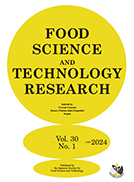Volume 30, Issue 1
Displaying 1-12 of 12 articles from this issue
- |<
- <
- 1
- >
- >|
Food Science and Chemistry
Review
-
2024Volume 30Issue 1 Pages 1-12
Published: 2024
Released on J-STAGE: January 19, 2024
Advance online publication: October 20, 2023Download PDF (2394K) Full view HTML
Food Technology and Engineering
Original papers
-
2024Volume 30Issue 1 Pages 13-24
Published: 2024
Released on J-STAGE: January 19, 2024
Advance online publication: September 11, 2023Download PDF (3915K) Full view HTML -
2024Volume 30Issue 1 Pages 25-36
Published: 2024
Released on J-STAGE: January 19, 2024
Advance online publication: November 02, 2023Download PDF (14099K) Full view HTML -
2024Volume 30Issue 1 Pages 37-46
Published: 2024
Released on J-STAGE: January 19, 2024
Advance online publication: November 08, 2023Download PDF (2153K) Full view HTML
Technical paper
-
2024Volume 30Issue 1 Pages 47-56
Published: 2024
Released on J-STAGE: January 19, 2024
Advance online publication: November 09, 2023Download PDF (1588K) Full view HTML
Notes
-
2024Volume 30Issue 1 Pages 57-62
Published: 2024
Released on J-STAGE: January 19, 2024
Advance online publication: October 03, 2023Download PDF (1776K) Full view HTML
Food Science and Chemistry
Original papers
-
2024Volume 30Issue 1 Pages 63-74
Published: 2024
Released on J-STAGE: January 19, 2024
Advance online publication: August 11, 2023Download PDF (2478K) Full view HTML -
2024Volume 30Issue 1 Pages 75-82
Published: 2024
Released on J-STAGE: January 19, 2024
Advance online publication: September 07, 2023Download PDF (3338K) Full view HTML -
2024Volume 30Issue 1 Pages 83-95
Published: 2024
Released on J-STAGE: January 19, 2024
Advance online publication: October 11, 2023Download PDF (2215K) Full view HTML -
2024Volume 30Issue 1 Pages 97-106
Published: 2024
Released on J-STAGE: January 19, 2024
Advance online publication: October 23, 2023Download PDF (2460K) Full view HTML -
2024Volume 30Issue 1 Pages 107-115
Published: 2024
Released on J-STAGE: January 19, 2024
Advance online publication: November 01, 2023Download PDF (2138K) Full view HTML
Note
-
2024Volume 30Issue 1 Pages 117-123
Published: 2024
Released on J-STAGE: January 19, 2024
Advance online publication: October 18, 2023Download PDF (2869K) Full view HTML
- |<
- <
- 1
- >
- >|
